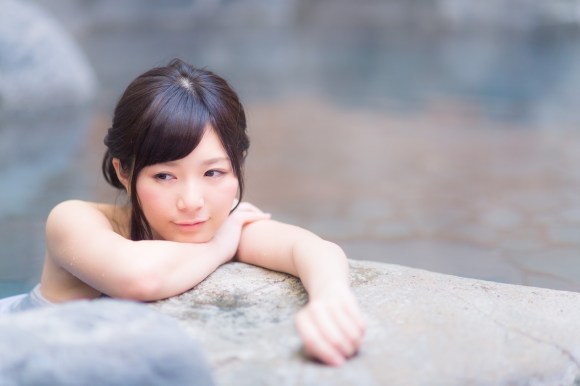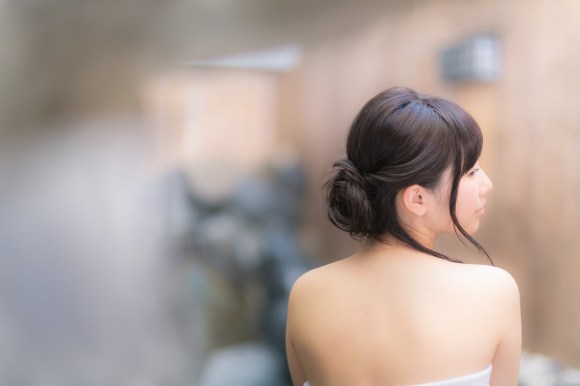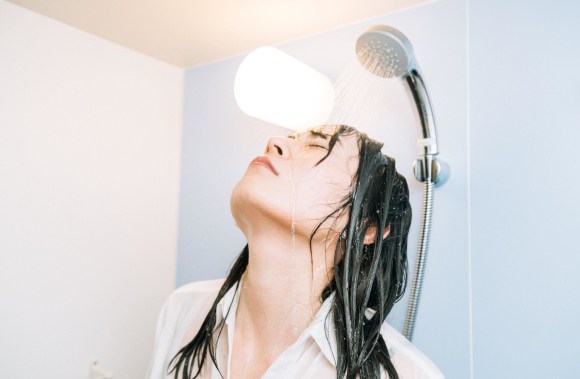
Responses suggest many women don’t have time to bathe every day anymore.
In Japan, people traditionally end every day with a soak in the tub. This emphasis on bathing, as opposed to showering, is one that comes from the old tradition of sento, or bath houses, which were commonly used by people back when households weren’t equipped with bathing facilities.
Today, people still maintain the same ritual of washing and scrubbing before entering the bath, which is filled up with hot water and shared by family members throughout the evening. If you’ve ever had the chance to soak in a Japanese tub at home, you’ll know just how amazing these contraptions can be, with built-in heating elements that keep the bath at a constant temperature, control panels in and outside of the bathroom for operating the level and temperature of the water, including the time you want it filled, and, if you’re lucky, a small television screen.
▼ Discover the wonders of the Japanese bath in this video below.
With this much enjoyment to be had in the bathroom, it’s natural to be curious about how long the average person stays in there, so the Japan Health and Research Institute and the Onsen Medical Science Research Centre recently asked 500 women between the ages of 20 and 49 to reveal their bathing habits. Out of all the women surveyed, 96.8 percent said they bathe at night, in keeping with traditional bathing rituals, however, many of them revealed some surprises when it comes to other details about what they do in the bathroom. Let’s take a look at the results below!
How long do you spend in the bath?
1. 10-20 minutes (43.2 percent)
2. 20-30 minutes (28 percent)
3. 5-10 minutes (13 percent)
4. 30-60 minutes (12.4 percent)
5. Less than 5 minutes (2.2 percent)
6. More than 60 minutes (1 percent)
The majority of respondents said they typically spend 10-20 minutes in the bath, with a slightly longer time of 20-30 minutes being the next most popular option. Further down the list we have two extremes of a hop-in-hop-out situation and a more extensive soak that lasts for longer than an hour. Looking at the results overall, though, it’s apparent that the majority of women aren’t bathing for that long, and the reasons for that are revealed in the responses to the next question.
How do you usually spend your time in the bath?
1. I make do with just a shower (45.7 percent)
2. I soak in the bath for a short time (33.5 percent)
3. I take my time in the bath (20.1 percent)
4. Other (0.6 percent)
Surprisingly, almost half of the respondents said they don’t even get into the bath, choosing to make do with a quick shower instead. With more and more women now in the workforce, busy schedules appear to be getting in the way of traditional daily bath-time rituals, and for those living on their own, it’s sometimes easier to do away with the fuss of having to clean the bath every day after you use it, which is common practice in Japan. This all brings us to the next question: how often do women bathe, if they bathe at all?
How frequently do you bathe in a week?
1. Every day (36.6 percent)
2. Less than once a week (24.4 percent)
3. Once a week (8.5 percent)
4. Three times a week (8.5 percent)
5. Four times a week (7.3 percent)
6. Five times a week (6.1 percent)
7. Twice a week (4.9 percent)
8. Six times a week (3.7 percent)
With just over 46 percent of respondents falling in the three-times-a-week-or-less category, it’s clear to see that more and more women aren’t bathing every day. Only 36.6 percent of women surveyed are actually sticking to the traditional daily bathing ritual while 24.4 percent bathe less than once a week, which are interesting stats for sociologists and bath manufacturers alike.
According to the results, traditional bath-time culture appears to be changing rapidly in Japan. Still, while women might not be bathing as often at home, that’s not to say they don’t enjoy a good soak, which is probably why getaways to hot spring destinations like these are always in high demand.
Source: Livedoor News via Otakomu
Featured image: Pakutaso
Insert images: Pakutaso (1, 2)



 10 best Studio Ghibli anime, as picked by Japanese fans– Different ages have different answers
10 best Studio Ghibli anime, as picked by Japanese fans– Different ages have different answers Survey reveals that Japanese women’s ideal husband is surprisingly ordinary
Survey reveals that Japanese women’s ideal husband is surprisingly ordinary How much do Japanese men and women pay on dates? Survey finds large gap
How much do Japanese men and women pay on dates? Survey finds large gap “Scholar” tops list of what Japanese boys want to be when they grow up, “restauranteur” for girls
“Scholar” tops list of what Japanese boys want to be when they grow up, “restauranteur” for girls What do Japanese kids want to be when they grow up? Businesspeople
What do Japanese kids want to be when they grow up? Businesspeople How to order snacks on a Shinkansen bullet train in Japan
How to order snacks on a Shinkansen bullet train in Japan Japan’s new difficult-to-drink-from beer glass protects your liver, but it’s a brutal experience
Japan’s new difficult-to-drink-from beer glass protects your liver, but it’s a brutal experience Burger King Japan suddenly adds Dr. Pepper and Dr. Pepper floats to its menu nationwide
Burger King Japan suddenly adds Dr. Pepper and Dr. Pepper floats to its menu nationwide Demon Slayer: Kimetsu no Yaiba gets new roller coaster attractions and food at Universal Studios Japan
Demon Slayer: Kimetsu no Yaiba gets new roller coaster attractions and food at Universal Studios Japan Hello, cosmetics! Clinique teams up with Hello Kitty this summer for first-time collaboration
Hello, cosmetics! Clinique teams up with Hello Kitty this summer for first-time collaboration Kyoto Tower mascot termination reveals dark side behind cute Japanese characters
Kyoto Tower mascot termination reveals dark side behind cute Japanese characters Nintendo history you can feel – Super NES, N64, and GameCube controllers become capsule toys
Nintendo history you can feel – Super NES, N64, and GameCube controllers become capsule toys This Nara workshop has been making deer crackers for more than 100 years and offers tours【Photos】
This Nara workshop has been making deer crackers for more than 100 years and offers tours【Photos】 High-fashion Totoro cuddle purse is like an elegant stroll in the forest【Photos】
High-fashion Totoro cuddle purse is like an elegant stroll in the forest【Photos】 Legendary Melon Bread by Tokyo Banana returns after 20-year absence【Taste Test】
Legendary Melon Bread by Tokyo Banana returns after 20-year absence【Taste Test】 “The most Delicious Cup Noodle in history” – Japan’s French Cup Noodle wins our heart【Taste test】
“The most Delicious Cup Noodle in history” – Japan’s French Cup Noodle wins our heart【Taste test】 Starbucks releases a cute Frappuccino and Unicorn Cake…but not in Japan
Starbucks releases a cute Frappuccino and Unicorn Cake…but not in Japan McDonald’s Japan’s Soft Twist Tower: A phantom ice cream only sold at select branches
McDonald’s Japan’s Soft Twist Tower: A phantom ice cream only sold at select branches Yabai Ramen: What makes this Japanese ramen so dangerous?
Yabai Ramen: What makes this Japanese ramen so dangerous? Finally! Nintendo Japan expands Switch 8-bit controller sales to everybody, Online member or not
Finally! Nintendo Japan expands Switch 8-bit controller sales to everybody, Online member or not Japanese government wants to build luxury resorts in all national parks for foreign tourists
Japanese government wants to build luxury resorts in all national parks for foreign tourists To combat declining birth rate, Japan to begin offering “Breeding Visas” to foreigners
To combat declining birth rate, Japan to begin offering “Breeding Visas” to foreigners 10 things you should buy at 7-Eleven in Japan
10 things you should buy at 7-Eleven in Japan Studio Ghibli releases anime heroine cosplay dresses that are super comfy to wear
Studio Ghibli releases anime heroine cosplay dresses that are super comfy to wear Woman charged for driving suitcase without a license in Osaka
Woman charged for driving suitcase without a license in Osaka Studio Ghibli unveils My Neighbour Totoro miniature house model
Studio Ghibli unveils My Neighbour Totoro miniature house model Kyoto experiencing problems with foreign tourists not paying for bus fares, but not on purpose
Kyoto experiencing problems with foreign tourists not paying for bus fares, but not on purpose Fighting mild hunger with a Japanese soda that turns into jelly in the stomach【Taste test】
Fighting mild hunger with a Japanese soda that turns into jelly in the stomach【Taste test】 Studio Ghibli’s Howl’s Moving Castle tapestry unveiled in Japan for first time
Studio Ghibli’s Howl’s Moving Castle tapestry unveiled in Japan for first time McDonald’s new Happy Meals offer up cute and practical Sanrio lifestyle goods
McDonald’s new Happy Meals offer up cute and practical Sanrio lifestyle goods Sales of Japan’s most convenient train ticket/shopping payment cards suspended indefinitely
Sales of Japan’s most convenient train ticket/shopping payment cards suspended indefinitely Sold-out Studio Ghibli desktop humidifiers are back so Totoro can help you through the dry season
Sold-out Studio Ghibli desktop humidifiers are back so Totoro can help you through the dry season Japanese government to make first change to romanization spelling rules since the 1950s
Japanese government to make first change to romanization spelling rules since the 1950s Foreigner’s request for help in Tokyo makes us sad for the state of society
Foreigner’s request for help in Tokyo makes us sad for the state of society Ghibli founders Toshio Suzuki and Hayao Miyazaki contribute to Japanese whisky Totoro label design
Ghibli founders Toshio Suzuki and Hayao Miyazaki contribute to Japanese whisky Totoro label design Doraemon found buried at sea as scene from 1993 anime becomes real life【Photos】
Doraemon found buried at sea as scene from 1993 anime becomes real life【Photos】 Tokyo’s most famous Starbucks is closed
Tokyo’s most famous Starbucks is closed Princesses, fruits, and blacksmiths: Study reveals the 30 most unusual family names in Japan
Princesses, fruits, and blacksmiths: Study reveals the 30 most unusual family names in Japan How often do Japanese high school kids watch anime, and do boys and girls watch the same series?
How often do Japanese high school kids watch anime, and do boys and girls watch the same series? Survey says more sixth graders in Japan aspire to work in medicine this year than last year
Survey says more sixth graders in Japan aspire to work in medicine this year than last year How many times a day do Japanese men adjust their junk? New survey investigates
How many times a day do Japanese men adjust their junk? New survey investigates What are the most and least attractive hobbies for Japanese men and women? Survey investigates
What are the most and least attractive hobbies for Japanese men and women? Survey investigates What do Japanese kids want to be when they grow up? For 30 percent of boys, YouTubers, survey says
What do Japanese kids want to be when they grow up? For 30 percent of boys, YouTubers, survey says Japanese husbands in survey say they do half the housework and childcare, wives say “Nope!”
Japanese husbands in survey say they do half the housework and childcare, wives say “Nope!” 12/21 is Japan’s “Long Distance Lovers Day”: What makes it so hard to keep up long distance love?
12/21 is Japan’s “Long Distance Lovers Day”: What makes it so hard to keep up long distance love? Rub-a-dub-dub and relax in a tub: Survey reveals wintertime bathing habits across Japan
Rub-a-dub-dub and relax in a tub: Survey reveals wintertime bathing habits across Japan Japanese women asked what best job for a husband is, may be looking for romantic-comedy lead
Japanese women asked what best job for a husband is, may be looking for romantic-comedy lead Which jobs in Japan have the most and least overtime? Survey investigates
Which jobs in Japan have the most and least overtime? Survey investigates Japan’s favorite Pokémon types by prefecture–which types are the most popular?
Japan’s favorite Pokémon types by prefecture–which types are the most popular? Japanese survey picks “slightly plump” as the cutest body type for women
Japanese survey picks “slightly plump” as the cutest body type for women Should married couples in Japan be allowed to have different family names? Survey investigates
Should married couples in Japan be allowed to have different family names? Survey investigates Over 30 percent of surveyed Japanese managers feel intense stress from working with foreigners
Over 30 percent of surveyed Japanese managers feel intense stress from working with foreigners Mario isn’t number one? Nintendo plumber doesn’t win Super Mario series character popularity poll
Mario isn’t number one? Nintendo plumber doesn’t win Super Mario series character popularity poll Lots of Japanese parents want their kids to work for Nintendo, but not just for the money, survey says
Lots of Japanese parents want their kids to work for Nintendo, but not just for the money, survey says
Leave a Reply